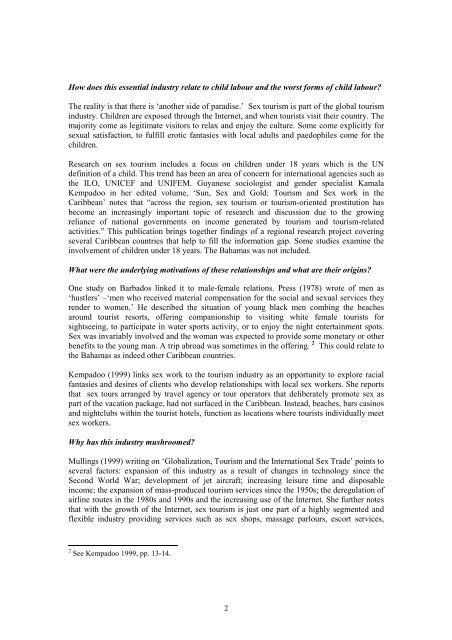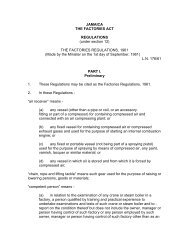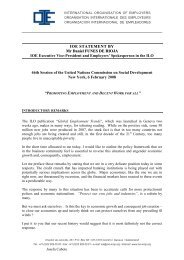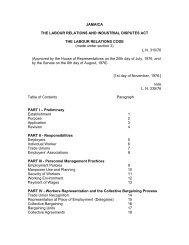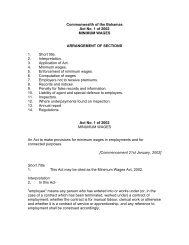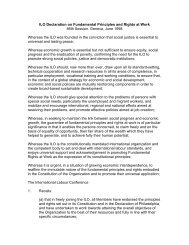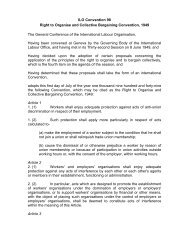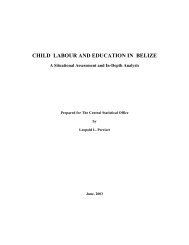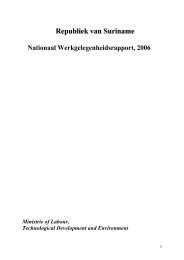ILO REPORT ON CHILD LABOUR IN BARBADOS - International ...
ILO REPORT ON CHILD LABOUR IN BARBADOS - International ...
ILO REPORT ON CHILD LABOUR IN BARBADOS - International ...
You also want an ePaper? Increase the reach of your titles
YUMPU automatically turns print PDFs into web optimized ePapers that Google loves.
How does this essential industry relate to child labour and the worst forms of child labour?<br />
The reality is that there is ‘another side of paradise.’ Sex tourism is part of the global tourism<br />
industry. Children are exposed through the Internet, and when tourists visit their country. The<br />
majority come as legitimate visitors to relax and enjoy the culture. Some come explicitly for<br />
sexual satisfaction, to fulfill erotic fantasies with local adults and paedophiles come for the<br />
children.<br />
Research on sex tourism includes a focus on children under 18 years which is the UN<br />
definition of a child. This trend has been an area of concern for international agencies such as<br />
the <strong>ILO</strong>, UNICEF and UNIFEM. Guyanese sociologist and gender specialist Kamala<br />
Kempadoo in her edited volume, ‘Sun, Sex and Gold: Tourism and Sex work in the<br />
Caribbean’ notes that “across the region, sex tourism or tourism-oriented prostitution has<br />
become an increasingly important topic of research and discussion due to the growing<br />
reliance of national governments on income generated by tourism and tourism-related<br />
activities.” This publication brings together findings of a regional research project covering<br />
several Caribbean countries that help to fill the information gap. Some studies examine the<br />
involvement of children under 18 years. The Bahamas was not included.<br />
What were the underlying motivations of these relationships and what are their origins?<br />
One study on Barbados linked it to male-female relations. Press (1978) wrote of men as<br />
‘hustlers’ –‘men who received material compensation for the social and sexual services they<br />
render to women.’ He described the situation of young black men combing the beaches<br />
around tourist resorts, offering companionship to visiting white female tourists for<br />
sightseeing, to participate in water sports activity, or to enjoy the night entertainment spots.<br />
Sex was invariably involved and the woman was expected to provide some monetary or other<br />
benefits to the young man. A trip abroad was sometimes in the offering. 2 This could relate to<br />
the Bahamas as indeed other Caribbean countries.<br />
Kempadoo (1999) links sex work to the tourism industry as an opportunity to explore racial<br />
fantasies and desires of clients who develop relationships with local sex workers. She reports<br />
that sex tours arranged by travel agency or tour operators that deliberately promote sex as<br />
part of the vacation package, had not surfaced in the Caribbean. Instead, beaches, bars casinos<br />
and nightclubs within the tourist hotels, function as locations where tourists individually meet<br />
sex workers.<br />
Why has this industry mushroomed?<br />
Mullings (1999) writing on ‘Globalization, Tourism and the <strong>International</strong> Sex Trade’ points to<br />
several factors: expansion of this industry as a result of changes in technology since the<br />
Second World War; development of jet aircraft; increasing leisure time and disposable<br />
income; the expansion of mass-produced tourism services since the 1950s; the deregulation of<br />
airline routes in the 1980s and 1990s and the increasing use of the Internet. She further notes<br />
that with the growth of the Internet, sex tourism is just one part of a highly segmented and<br />
flexible industry providing services such as sex shops, massage parlours, escort services,<br />
2 See Kempadoo 1999, pp. 13-14.<br />
2


